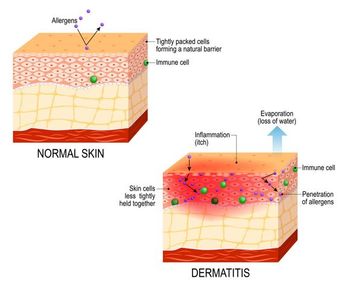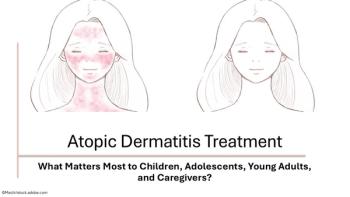
Management of Congenital Adrenal Hyperplasia in Adults: Challenges with Standard of Care
The standard of care for congenital adrenal hyperplasia has not changed in more than 60 years nor have the challenges it presents been overcome.
For more than 70 years, the treatment paradigm for individuals with congenital adrenal hyperplasia (CAH) has required clinicians to tread the fine line between reducing excessive production of adrenal androgens without exposing individuals to the dangerous side effects of high-dose corticosteroid therapy.
Although the introduction of hormone replacement therapy in the 1950s and the advent of neonatal screening programs, now universal in the US, have radically improved neonatal survival rates for the disorder,1-4 CAH requires lifelong complex therapeutic management. Treatment is made more challenging by the multiple long-term complications related to the disease itself and to the primary medications (ie, glucocorticoids [GCs]) that affect growth and development, metabolic and cardiovascular health, fertility, and mental health.1-4
CAH At-a-Glance
CAH is a group of autosomal recessive disorders that lead to complex hormonal imbalances related to enzyme deficiencies in the adrenal steroidogenic pathway. Between 95% to 99% of diagnosed cases are caused by 21-hydroxylase deficiency (21OHD), which is in turn caused by CYP21A2 gene mutations.1-5 The myriad CYP21A2 allelic variants are associated with a broad spectrum of phenotypes.1,3 Deficiency of 21OH leads to marked cortisol deficiency and the majority of affected individuals, to aldosterone deficiency.3 Regardless of degree of 21OH deficiency, however, the result common to all types is excessive adrenal androgens.1-5
CAH Types. 21OH-deficiency CAH manifests in 2 forms: the more severe classic form and the milder non-classic form. The classic form, the type focused on here, is considered a rare disease and is observed in 1 in 14 000 to 18 000 births globally.2 Classic CAH also is subdivided, into the severe salt-wasting form caused by complete enzyme ablation and simple virilizing CAH, associated with CYP21A2 mutations that retain less than 5% of enzyme activity and also some aldosterone-producing capacity. However, all categories of CAH can potentially lead to adrenal crisis.1-5
21OH Deficiency. Adequate 21OH is required for adrenal production of appropriate levels of cortisol and aldosterone. Adrenal insufficiency leads to a cascade of failures and most importantly the loss of negative feedback to the hypothalamic-pituitary-adrenal (HPA) axis.1-5 Without the negative feedback, hypothalamic secretion of corticotropin-releasing factor (CRF) increases with subsequent binding to CRF1 receptors in the pituitary gland; the result is a counter-regulatory overproduction of adrenocorticotropic hormone (ACTH).1-5 The surfeit of ACTH leads to overproduction of cortisol precursors, including androstenedione and 17‐hydroxyprogesterone (17-OHP), which are then shunted to available androgen synthesis pathways, resulting in excessive androgen production.1-5
Adrenal Androgen Excess. Sequelae of adrenal androgen excess during childhood include virilization, accelerated somatic growth with advanced bone age, precocious puberty, and failure to achieve average adult height.2-4 Typical symptoms among adult women are hirsutism, acne, and irregular menses; among men testicular adrenal rest tumors (TARTs) are common. Hypogonadism and infertility may affect both men and women, either alone or together.1-3
Therapeutic Goals, Challenges
The goals of treatment for individuals with CAH differ from those for other forms of adrenal insufficiency given the 2-fold end: first, to address hormone deficiencies through replacement and second to reduce excessive levels of adrenal androgens.1-7 The standard of care for CAH—GC replacement therapy—has been consistent for decades.
Adequate suppression of androgen production during early life is critical to allow normal growth and development including achievement of average adult height.1-5 Higher than average doses of GCs during the sensitive developmental periods of infancy and puberty, however, are associated with decreased final adult height, making careful monitoring of drug dose, dosing, and subsequent adjustment essential.1-5
CAH Management in Adulthood
Duration of GC effect and dosage should be reevaluated during the transition from childhood to adolescence and again in emerging adulthood when full height is reached.1-5 The clinical parameters used to guide early GC therapy no longer pertain for adults with 21OH-deficiency CAH and although the need for lifelong treatment continues, lack of consensus on appropriate GC regimens for adults is longstanding.2,8 Adding to the challenge of optimizing GC therapy in the older CAH population is the wide range in amount of adrenal hyperplasia present at the transition to adulthood as well as the potential lasting effects of poor control in childhood and adolescence.2,6,9
Central to adjustment of the GC regimen to meet the changing needs and priorities of adult life is achieving balance between cortisol replacement and androgen management and mitigation of the treatment consequences.2,4,6 Physiologic doses of GCs are sufficient to manage the inherent cortisol deficiency of CAH. To indirectly regulate adrenal androgen production via restoration of negative feedback to the HPA axis, however, most often requires supraphysiologic GC doses. When effective, the high doses do reduce hypothalamic CRF, leading to reduced activation of CRF1 receptors and suppression of ACTH-driven androgen excess.1-5
Yet for many adults with CAH, even the supraphysiologic doses of GCs are not sufficient to reduce the overproduction of androgens. Research shows that androgen levels remain poorly managed with GC therapy in up to two-thirds of adults with CAH.2,4,7
In a recent multicenter study of young adults (median age 33 years) with CAH receiving GC therapy, the prevalence of disorder-related cardiometabolic and bone comorbidities persisted despite treatment, including osteoporosis/osteopenia, hyperlipidemia, type 2 diabetes, and hypertension.10 The long-term exposure to high-dose GCs in adulthood compounds comorbidities of the disorder and increases the risk for treatment-related adverse events, including for iatrogenic Cushing syndrome.2,4,5,9
Infertility is among the chief concerns of a proportion of adults with CAH. For women, restoration of the ability to conceive typically requires short-term increased intensity of GC treatment.2,6 Men may experience compromised testicular function related to GC therapy but intensifying treatment in an effort to overcome infertility may lead to further suppression of the hypothalamic-pituitary-gonadal axis.2,11
Treatment Response
Response to different types and formulations of GCs available for adult treatment is wide and variable, both within and between individuals.2,8 Careful monitoring is required for signs of GC overtreatment and for signs of inadequate normalization of androgens2 and is made more challenging by the narrow therapeutic index associated with some synthetic GCs.4 Consistent timing of hormone measurements is required for optimal understanding of metabolic control2 although the variability of traditional biomarkers of control (17-hydroxyprogesterone and androstenedione) is well recognized, with stress leading to an acute increase and a dose of GC precipitating a decrease.4 Neither are the 2 markers in wide use adrenal-specific.4
For adults with CAH who have difficulty reaching and maintaining a balance between effective treatment and side effects that challenge quality of life, the shifting medication routines and need for ongoing monitoring to allow adjustment, may lead to refusal of treatment, according to experts.9
The absence of consensus guidelines leaves both adult patients and their health care providers in a clinical hall of mirrors where the replicating images suggest the ongoing treatment decisions, changes, variable outcomes, and subsequent treatment decisions.
There is significant progress, however, in the development of medications designed to overcome the decades-old challenge of managing CAH with GCs. These include novel approaches to physiologic cortisol replacement with modified-release GC formulations and, importantly, non-GC strategies that directly address ACTH-driven androgen excess, separating control of that process from GC treatment of cortisol deficiency.4
References
1. Auer MK, Nordenström A, Lajic S, Reisch N. Congenital adrenal hyperplasia. Lancet. 2022;401(10374): 1-18. doi:10.1016/S0140-6736(22)01330-7
2. Speiser PW, Arlt W, Auchus RJ, et al. Congenital adrenal hyperplasia due to steroid 21-hydroxylase deficiency: an Endocrine Society Clinical Practice Guideline. J Clin Endocrinol Metab. 2018;103(11):4043-4088. doi:10.1210/jc.2018-01865
3. Claahsen-van der Grinten HL, Speiser PW, Ahmed SF, et al. Congenital adrenal hyperplasia—current insights in pathophysiology, diagnostics, and management. Endocr Rev. 2022;43(1):91-159. doi:10.1210/endrev/bnab016
4. Mallappa A, Merke DP. Management challenges and therapeutic advances in congenital adrenal hyperplasia. Nat Rev Endocrinol. 2022;18(6):337-352. doi: 10.1038/s41574-022-00655-w
5. Merke DP, Auchus RJ. Congenital adrenal hyperplasia due to 21-hydroxylase deficiency. N Engl J Med. 2020;383(13):1248-1261. doi:10.1056/NEJMra1909786
6 Auchus RJ, Arlt W. Approach to the patient: the adult with congenital adrenal hyperplasia. J Clin Endocrinol Metab. 2013;98:2645-2655. doi:10.1210/jc.2013-1440.
7. Turcu AF, Auchus RJ. Novel treatment strategies in congenital adrenal hyperplasia. Curr Opin Endocrinol Diabetes Obes. 2016;23(3):225-232. doi:10.1097/MED.0000000000000256
8. Whittle E, Falhammar H. Glucocorticoid regimens in the treatment of congenital adrenal hyperplasia: a systematic review and meta-analysis. J Endocr Soc. 2019;3(6):1227-1245. doi 10.1210/js.2019-00136 |
9. Auchus RJ. Management of the adult with congenital adrenal hyperplasia. Int J Ped Endocrinol. 2010;1-9. doi:10.1155/2010/614107
10. Righi B, Ali SR, Bryce J, et al. Long-term cardiometabolic morbidity in young adults with classic 21-hydroxylase deficiency congenital adrenal hyperplasia. Endocrine. 2023;80(3):630-638. doi:10.1007/s12020-023-03330-w
11. Pofi R, Ji X, Krone NP, Tomlinson JW. Long‐term health consequences of congenital adrenal hyperplasia. Clin Endocrinol. 2023;1–15. doi:10.1111/cen.14967
Newsletter
Enhance your clinical practice with the Patient Care newsletter, offering the latest evidence-based guidelines, diagnostic insights, and treatment strategies for primary care physicians.

















































































































































































































































































